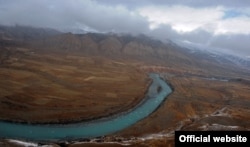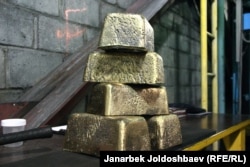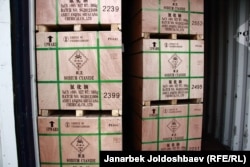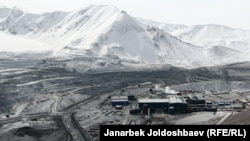
Campaigning for Kyrgyzstan's parliamentary elections does not officially start until September 4, but scandals, accusations, and confusion have already started.
Elections in Kyrgyzstan -- the lone democracy in Central Asia -- have always been raucous events. The 2005 parliamentary elections, for example, led to the ouster of President Askar Akaev in the Tulip Revolution.
But the vote set for October 4 might outdo all the previous polls as this time there are no clear favorites, which has raised the hopes of the at least 16 parties that will take part in the elections.
Three Minutes Late -- Confusion About Deadline
Just a few minutes after the 6 p.m. deadline passed for official party representatives to hand in registration documents -- including a list of candidates -- to the Central Election Commission (BShK) on August 24, there was the first problem.
The new Kyrgyzstan party apparently missed that deadline by three minutes, though party leader Kanat Isaev insists his people were not late.
On the registration book, the Kyrgyzstan party is signed in at 5:59 p.m., though there is evidence a previous entry had been written over and the person who handed over the documents neglected to put their signature next to the entry.
A video from the BShK office in Bishkek shows the Kyrgyzstan party representative in the office signing the book at 6:03 p.m.
At 6:20 p.m. on August 24, the BShK press service announced 17 parties, including the Kyrgyzstan party, had handed over the necessary documents but, shortly after, posts appeared on social networks in Kyrgyzstan claiming inconsistencies in the registration of the Kyrgyzstan party.
Representatives from several other parties along with civic activists came to the BShK office the next day to complain about the tardiness violation and were initially met by a BShK employee who reportedly said the clock on the surveillance camera was 13 minutes fast.
The group was not convinced and eventually the registration book was shown and inconsistencies in the Kyrgyzstan party's entry became apparent (see photo).
Representatives of the Ata-Meken (Fatherland), Reforms, Bir Bol (Stay Together), Ordo (The Center), and Chong Kazat (Great Crusade) parties complained to President Sooronbai Jeenbekov, the head of the state Security Committee, and the state ombudsman about the BSK decision to register Kyrgyzstan.
Later on August 25, the BShK announced it had rejected the Kyrgyzstan party's registration on the grounds that the authorized representative of the party was not the person who handed over the documents.
The party said their authorized representative was sick and could not deliver the documents.
Kyrgyzstan party head Isaev quickly announced the party would appeal the BShK decision in court and, on August 27, an administrative court in Bishkek ruled the BShK decision to reject the Kyrgyzstan party's documents was illegal, which party member Talant Mamytov said meant Kyrgyzstan could participate in the upcoming elections.
At the same time, the BShK's credibility was tarnished for initially registering a party -- Kyrgyzstan -- that is seen as pro-government, even if it later reversed its decision.
The BShK said on August 28 it would appeal the decision to reinstate the Kyrgyzstan party.
There might be other parties appealing BShK rulings soon. The BShK sent back the documents of 13 other parties, giving them 48 hours to make revisions or supply information that was lacking in the material originally presented for registration.
Who Is Running And Who Isn't?
As mentioned in a previous issue of Qishloq Ovozi, many Kyrgyz political parties have merged in previous elections, sometimes to boost their chances at the polls and sometimes because one or more parties were unable to register, so they joined ranks with a party that was already registered.
On August 18, the Mekenim Kyrgyzstan (My Homeland Kyrgyzstan) and Ata-Jurt (Fatherland) parties announced they were merging.
Ata-Jurt joined forces with Respublika (Republic) before the 2015 parliamentary elections and the combined effort resulted in Respublika/Ata-Jurt winning 28 seats in the 120-seat parliament, the second-highest number among the six parties that secured seats in those elections. The two parties formally split in November 2016 but maintained their alliance within parliament.
Ata-Jurt did not announce it would participate in the upcoming elections at the start of August when 44 other parties said they intended to. So its candidates will be running under the Mekenim Kyrgyzstan banner.
In early June, former Prime Minister Temir Sariev announced his Ak-Shumkar (White Falcon) party would join with Ata-Meken (Fatherland), the Liberal Democratic Party of Kyrgyzstan, and other groups to form the Zhany Dem (New Breath) political alliance for the upcoming elections.
On August 5, Sariev announced Ak-Shumkar was withdrawing from that group and on August 18 it was reported that Ak-Shumkar had merged into the Butun Kyrgyzstan (United Kyrgyzstan) party.
But on August 23, Sariev announced that Ak-Shumkar was withdrawing from that alliance and added that it would not take part in the elections.
On August 15, the Bir Bol and Democrat parties agreed to merge to "strengthen the interests of ordinary citizens who are hungry for change," but two days later the Democrat party announced it also was withdrawing from the elections.
Since independence in 1991, Feliks Kulov has been Kyrgyzstan's vice president, interior minister, security minister, Bishkek mayor, and prime minister. He created the Ar-Namys (Dignity) party in 1999 and the party took part in the 2007, 2010, and 2015 elections, but on August 18 Ar-Namys announced it would not participate in these elections.
Omurbek Tekebaev is the leader of the Ata-Meken party, but he is still officially under house arrest after a 2017 conviction on charges of corruption and fraud that many felt was part of a political vendetta against him by former President Almazbek Atambaev.
Tekebaev had already signaled he would not be running in the upcoming elections, but on August 17 he stated it clearly and said several other top members of the party would also not seek seats in these elections, even though the party is still registered and will be on the ballot.
Tekebaev said it is time "to clear the way for younger people" and repeated that 33-year-old Janar Akaev (a former reporter for RFE/RL's Kyrgyz Service) would top the party's list in the elections.
Several members of the Yyman Nuru (Ray of Faith) party complained on August 14 that their party was under pressure from other parties ahead of the vote, but the group declined to specify which parties or the form of pressure.
Mikhail Khalitov, a member of the party's political council, said they had advised any members "who have something to lose that they can leave the party."
Yyman Nuru party leader Aybek Osmonov, who interestingly was a founder of the Mekenim Kyrgyzstan party, was among the first to leave, formally making the announcement on August 18 without giving any reason. He was replaced by Nurjigit Kadyrbekov, a young religious leader who studied in the United States and Japan.
On August 16, the Chong Kazat party held its congress and replaced leader Tural Alimov, who made an unsuccessful attempt to run for president in 2017, with Maksat Mamytkanov, a former head of the state Security Committee's department for fighting organized crime.
All this activity is only the beginning, as the registered parties scramble to woo voters, parties that were not registered try to stay in the game by joining registered parties, and the courts deal with issues such as the late-registration charge against the Kyrgyzstan party.
It all adds up to what will certainly be an interesting campaign for parliamentary elections that appear to be highly unpredictable and the problems seen in Kyrgyzstan are on an entirely different level compared to those experienced by candidates and political parties in the other Central Asian countries.
















